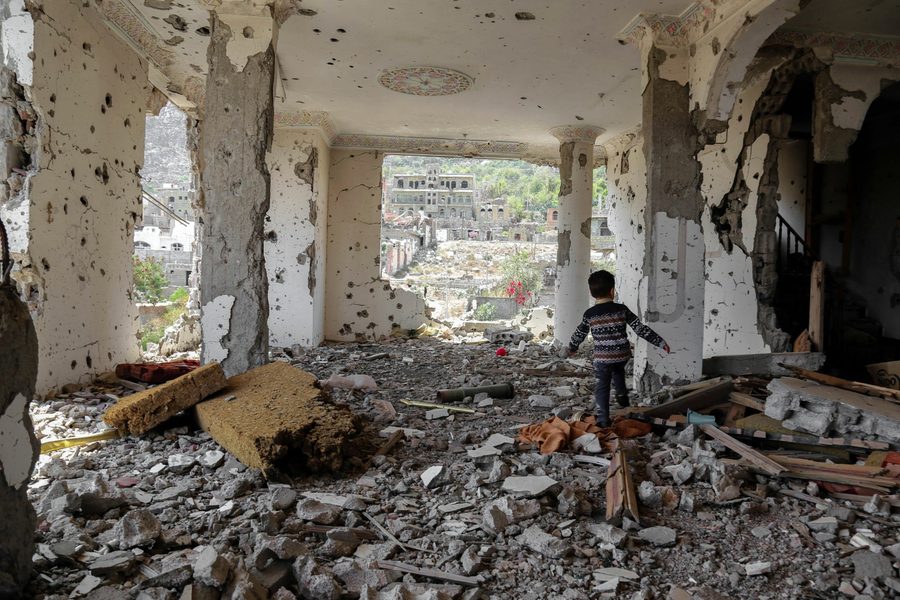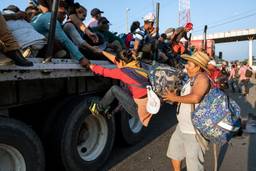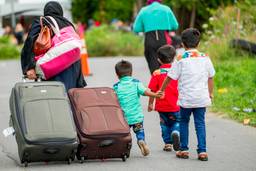The U.S. Isn’t Just Backing the Yemen War—It’s Helping Trap Those Forced to Flee
How the United States is helping Oman militarize its border with Yemen.
Khury Peterson-Smith

By now, the images are infamous: stunned, bloodied Yemeni children arriving at the hospital after their summer camp bus was bombed by Saudi aircraft. The United States is deeply implicated in that August 9 attack, which killed 54 people — most of them children
Fragments from the bomb bear the labels of U.S. weapons manufacturers. The indefensible nature of the bombing — there were no combatants anywhere in sight — has garnered headlines and even attention on Capitol Hill, opening a new conversation about U.S. involvement in the years-long siege of Yemen by a coalition headed by Saudi Arabia and the United Arab Emirates.
The coalition frames its war as an intervention on behalf of Abdrabbuh Mansur Hadi, the man they recognize as the legitimate president of Yemen. Saudi Arabia and the UAE claim to be targeting the Houthis, the opposition group on the other side of Yemen’s civil war that controls the country’s capital, and that has alleged ties with Iran. The images from the school bus attack, however, reveal the actual targets of the coalition’s air power.
While both the Houthis and the coalition take actions with destructive consequences for Yemen’s population, the overwhelming blame for the devastation and the humanitarian crisis lies with the United States, Saudi Arabia and the UAE.
The United States is supplying the aircraft to Saudi Arabia and the UAE, the precision munitions they’re dropping, intelligence and mid-air refueling of the coalition war planes. The United States also continues to carry out military operations in Yemen directly, with its own special forces and air strikes. But even when American personnel are not personally dropping the bombs, they seem to be involved in all of the other steps of the coalition’s operations.
On the same day of the attack on the school bus, and not far away, U.S. personnel were finishing up another, quieter activity that has received far less attention.
From August 5 through 9, a unit of the Wisconsin National Guard that was assigned to U.S. Army Central conducted a week-long training with members of the Royal Army of Oman’s Border Guard Brigade in Haima, Oman. The exercises were part of Oman’s militarization of its border with Yemen — with funding and other assistance from the United States.
In other words, not only is the United States. helping the coalition bomb Yemeni civilians. It’s helping trap the refugees fleeing that bombing.
Walls around the world
Before, it was clear that the American government wanted no Yemeni refugees in the United States. Yemen has been listed in all three iterations of the Trump administration’s anti-Muslim travel ban. That was unjust enough. In Oman, the United States is helping to prevent Yemenis from leaving their country at all.
In August, Congress passed the National Defense Authorization Act (NDAA) — its military budget — for the fiscal year of 2019. The Act calls on the Secretary of State to certify that Saudi Arabia and the UAE are taking steps to minimize civilian casualties, among other measures to assuage qualms that Congress may have about continuing the U.S. mid-air refueling program.
The restrictions laid out in the Act have come into the spotlight as Trump has signaled his refusal to abide by them, sparking a dispute between members of Congress and the White House about who has the authority to make decisions about foreign affairs — a fight that has been fueled by the horrendous school bus bombing.
But the same Act also quietly expands the list of countries that the United States supplies aid to for the purpose of militarizing their borders. A provision was added to the military budget in 2016 that appropriates such funding to “certain foreign countries for border security operations.” The list of countries — each of which is eligible for up to $150 million in the program — includes Tunisia, Egypt, Lebanon, and Jordan. The 2019 budget includes Pakistan and Oman.
What do these states have in common? They share borders with countries from which millions of refugees emerge or flow through. Egypt, Tunisia, Lebanon and Jordan neighbor Libya, Syria and Iraq. Pakistan borders Afghanistan.
Oman’s steps to “secure its border” sound familiar. In a trend taken up by states around the world — and championed by the White House — Oman is building a wall. Construction began five years ago and is slated to continue for another three years.
The U.S. has promised $2.5 million in aid to Oman for 2019 in a package under the heading “Peace and Security.” And a flurry of meetings between U.S. and Omani officials suggest deeper coordination could be underway.
In March, Defense Secretary Mattis met with Omani Sultan Qaboos bin Said Al Said and Defense Minister Badr bin Saud al Busaidi in Muscat to discuss enhancing military cooperation. At the end of July, Omani Foreign Minister Yusuf bin Alawi traveled to Washington and met with Mattis at the Pentagon, Secretary of State Pompeo, and members of Congress. Conversations focused on the bilateral relationship in regard to the ongoing crisis in Yemen.
And then there was the joint training in Haima.
Beyond the Bombings
Migration is difficult for Yemenis. Yemen was the poorest country in the Middle East before the war began in 2015. While there are more than 2 million internally displaced people in Yemen, poverty prevents Yemenis from leaving the country.
Despite the many obstacles, more than 190,000 Yemenis have fled to neighboring countries according the UNHCR, the UN’s refugee agency. Many of those who have left are in Oman, so the measures the country is taking with its U.S. ally will put up new obstacles to would-be refugees.
Remarkably, despite the nightmarish conditions that the United States, Saudi Arabia and the UAE have made in Yemen, it’s also the case that more than 280,000 people—mostly from the Horn of Africa — have sought refuge in Yemen. The measures that the United States is supporting with its allies, then, are not only devastating Yemenis. The cruelty of those actions extends to refugees from outside of Yemen who are now effectively stuck in the same conditions that are displacing — but imprisoning — Yemenis.
The wars that the United States is carrying out and supporting include wars on the freedom of movement and those who seek to exercise it. From the caging of children and adults at the border with Mexico to the bombing of children in Yemen with American weapons, this summer has demonstrated to the world that the United States isn’t only driving people from their homes — it’s preventing them from escaping to safety.
It is significant that U.S. support for the Saudi bombing is getting more critical attention. But from walls to travel bans, our government’s disastrous activities extend beyond the bombings alone. We need to identify and expose Washington’s many attacks on people around the world — and resist them all.
This article was produced in partnership with Foreign Policy In Focus.






